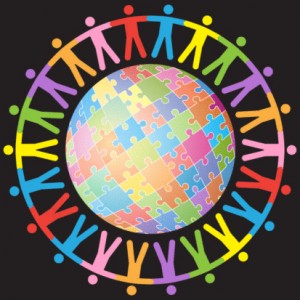Circus of Dreams (Part 12)
By Asher Crispe: November 30, 2012: Category Decoding the Tradition, Inspirations
To Light Up the Night
 Every dance has a movement and meaning all of its own. Dance choreography weighs both steps and relationships of the dancers. If we were to teach the dance of the future what would it look like? In the Talmud (Ta’anit 31b) we find that the future not only has a dance all its own but is itself composed as a dance for those who are worthy of it: “The future, the Holy One Blessed Be He [God], will make a dance [machol] for the righteous.” The expression does not say ‘in the future’ or that the dance will be ‘in’ the future but rather that the ‘future’ is made into a dance. This future as dance or dance-future exists for the righteous (tzaddikim) who are defined not only be their right conduct but by their capacity to properly connect with each other and with the Divine. In Yeshiyahu/Isaiah 60:21 this designation extends beyond its usual restricted usage in that “Your people are all righteous (tzaddikim).” Everyone gets to dance.
Every dance has a movement and meaning all of its own. Dance choreography weighs both steps and relationships of the dancers. If we were to teach the dance of the future what would it look like? In the Talmud (Ta’anit 31b) we find that the future not only has a dance all its own but is itself composed as a dance for those who are worthy of it: “The future, the Holy One Blessed Be He [God], will make a dance [machol] for the righteous.” The expression does not say ‘in the future’ or that the dance will be ‘in’ the future but rather that the ‘future’ is made into a dance. This future as dance or dance-future exists for the righteous (tzaddikim) who are defined not only be their right conduct but by their capacity to properly connect with each other and with the Divine. In Yeshiyahu/Isaiah 60:21 this designation extends beyond its usual restricted usage in that “Your people are all righteous (tzaddikim).” Everyone gets to dance.
Underneath this assertion is the implication that the negative qualities of a person are largely externalities, like stains on the garments of the soul whose essence is fundamentally good. Redemption, therefore, is not for some elite spiritual club. While some scrubbing of the soul garments (thought, speech and action) may be required before we are suitably dressed for the occasion, ultimately all of reality will provide the music and invite universal participation. Moreover, it’s not just that the ushering in of a utopic reality makes us feel like dancing, but that the dance particular to the future actual defines the social and spiritual relationships of the future. Allusions to this reality are embedded in the Hebrew term for the dance ‘machol’ which shares the same root as the word ‘machul’ which means to ‘pardon’ and ‘forgive.’ All of the undesirable qualities of a person stop the music and hold us back from dancing. Forgiveness overlooks both our own attire as well as that of the other (the soul garments of thought, speech and action) which keep us seated on the sidelines.
The origin of this dance relates to the soul power (sefirah) known as binah or ‘understanding.’ Understanding in Kabbalah is symbolized as the ‘mother’ image in the mind. If each of us come from a common mother, if we issue from the same womb; then we have a shared understanding. In Psalms 113:9 we read of the “…mother of children [who] rejoices.” These offspring or new states of consciousness are born out of the selfsame conception and comprehension (binah). This commonly held understanding envelopes us like children in the womb of one mother. Feeling this shared sense, we experience joy. When we share this mutual understanding, we can get past our hangups with each other and be uplifted in the process. This can also be reversed: when I am carried away with joy, all of the fences and barriers that prevent me from coming to an understanding dissolve. Thus joy (simchah) can also produce understanding just as understanding can lead to an experience of joy.
Once again returning to our dance typology, we can extrapolate its essential movements from the word machol in that Rashi and others explain that it means to dance in a circle (egul) or the shape of the Samech. Why is a circle the celebratory dance configuration of the future? Progressing on in the symbolic order of the Samech, this next aspect of the constellation of its meanings establishes the circle as the geometric figure of equality. As each of us dances round and round in the circle, we are all able to look to the common center. We are all equal distance from that center as we take position along the circumference. As we rotate, each dancer gets to temporarily occupy the place of all of the others. I will at times put myself in your place.
Conceptually, taking turns trading places leads to enhanced understanding and with this, the accompanying joy helps a person to forget and forgive the differences that other social shapes (and dances) burden us with–the stratifications and hierarchies–that keep us at a distance and limit our dance partners on account of the limited access to privileged positions. I cannot understand you nor can you understand me because we have never been in each other’s place. We were born of different mothers. While I may occupy the center of my own dance floor, you are marginalized. My egology seeks to make me the center of the world and therefore focuses on our differences rather than our similarities.
The future fix for this happens when we acknowledge the kinship of zero and infinity in nullifying the finite differences of the rest of our integers. If I compare 5 to 1000 I get 995, the gap separating them. Yet, when I subtract 5 or 1000 or 100,000,000 from infinity there is still only infinity. On some level, all finite difference amounts to zero (graphically a circle) or nothing when infinity comes into play. While mathematical infinity has much that can be said about it, Divinity is only likened to the infinite (as one of the Divine modes of self-expression). If the Divine becomes more revealed in the future, then all our quantifiable differences collapse to the same place as it were (along the circumference). In a Divine-centric universe, we are all in some sense equally close or far to such ‘infinite’ revelation. The celebration is one of our all ‘being equal’ in the circle with respect to the ‘Divine’ center. Each of us has a different ‘slice of life,’ or ‘angular perspective’ that cuts in on that center from a multitude of directions, but the stairs and levels have all collapsed to a common plane with the one and the same center.
 With everyone becoming an integral part of the circle, all differences at this point are only felt in the ‘run and return’ (ratzo v’shuv) or drawing closer into a tighter packed circle or pulling out into a broader and more distant circle. This may be compared to cycles (circle or Samech also represents a cycle) of marital intimacy with alternating times of relative closeness verses comparative distance. After time apart, the return to the intensity of intimacy rekindles the relationship. At it’s maximum effectiveness, each new ‘close’ encounter feels the wonderment of the ‘first time,’ a refreshing experience that is set out in Yirmeyahu/Jeremiah 31:12 for the future: “Then the virgin will rejoice in the dance, both young and old together….” Here the word of dance is once again machol, the ‘circle-dance.’ We will all return to virginal experience where this novel dimension of life de-differentiates the young and old within all of us. My past, who I used to be, oscillates in sync with who I have just become. The future synthesizes past and present into a state so unpredictable that I cannot anticipate exactly what it will be like until I actually experience it. Pure futurity strips us of our familiarity with the world and ourselves. Everything in this circle-dance is entirely new. In Kabbalah, the state of virginity often refers to a new soul that has never entered into a body. The coupling of a new soul and a body revamps reality. A new ‘corporation’ is formed. Everything is equally new. With the joy of starting over, we are granted another opportunity to get to know ourselves and others all over again.
With everyone becoming an integral part of the circle, all differences at this point are only felt in the ‘run and return’ (ratzo v’shuv) or drawing closer into a tighter packed circle or pulling out into a broader and more distant circle. This may be compared to cycles (circle or Samech also represents a cycle) of marital intimacy with alternating times of relative closeness verses comparative distance. After time apart, the return to the intensity of intimacy rekindles the relationship. At it’s maximum effectiveness, each new ‘close’ encounter feels the wonderment of the ‘first time,’ a refreshing experience that is set out in Yirmeyahu/Jeremiah 31:12 for the future: “Then the virgin will rejoice in the dance, both young and old together….” Here the word of dance is once again machol, the ‘circle-dance.’ We will all return to virginal experience where this novel dimension of life de-differentiates the young and old within all of us. My past, who I used to be, oscillates in sync with who I have just become. The future synthesizes past and present into a state so unpredictable that I cannot anticipate exactly what it will be like until I actually experience it. Pure futurity strips us of our familiarity with the world and ourselves. Everything in this circle-dance is entirely new. In Kabbalah, the state of virginity often refers to a new soul that has never entered into a body. The coupling of a new soul and a body revamps reality. A new ‘corporation’ is formed. Everything is equally new. With the joy of starting over, we are granted another opportunity to get to know ourselves and others all over again.
For Part 13 our attention moves on to the beginning of the end and the end of the beginning.
http://www.interinclusion.org/inspirations/circus-of-dreams-part-13/
Circus of Dreams (Part 12),






















;)
;)
;)
;)
;)
;)
;)
;)
;)
